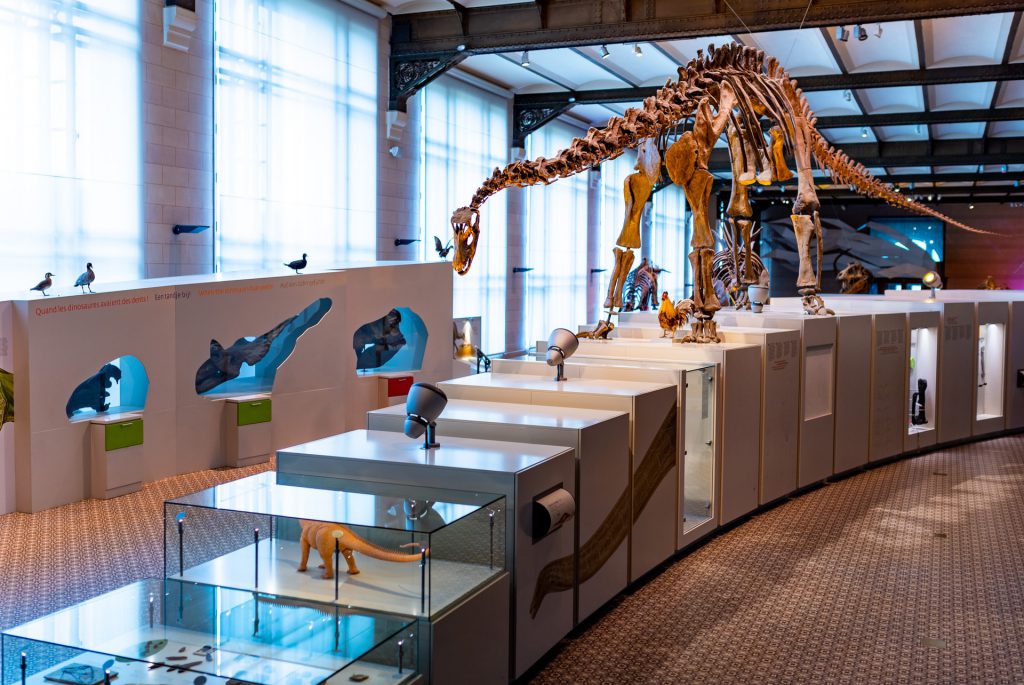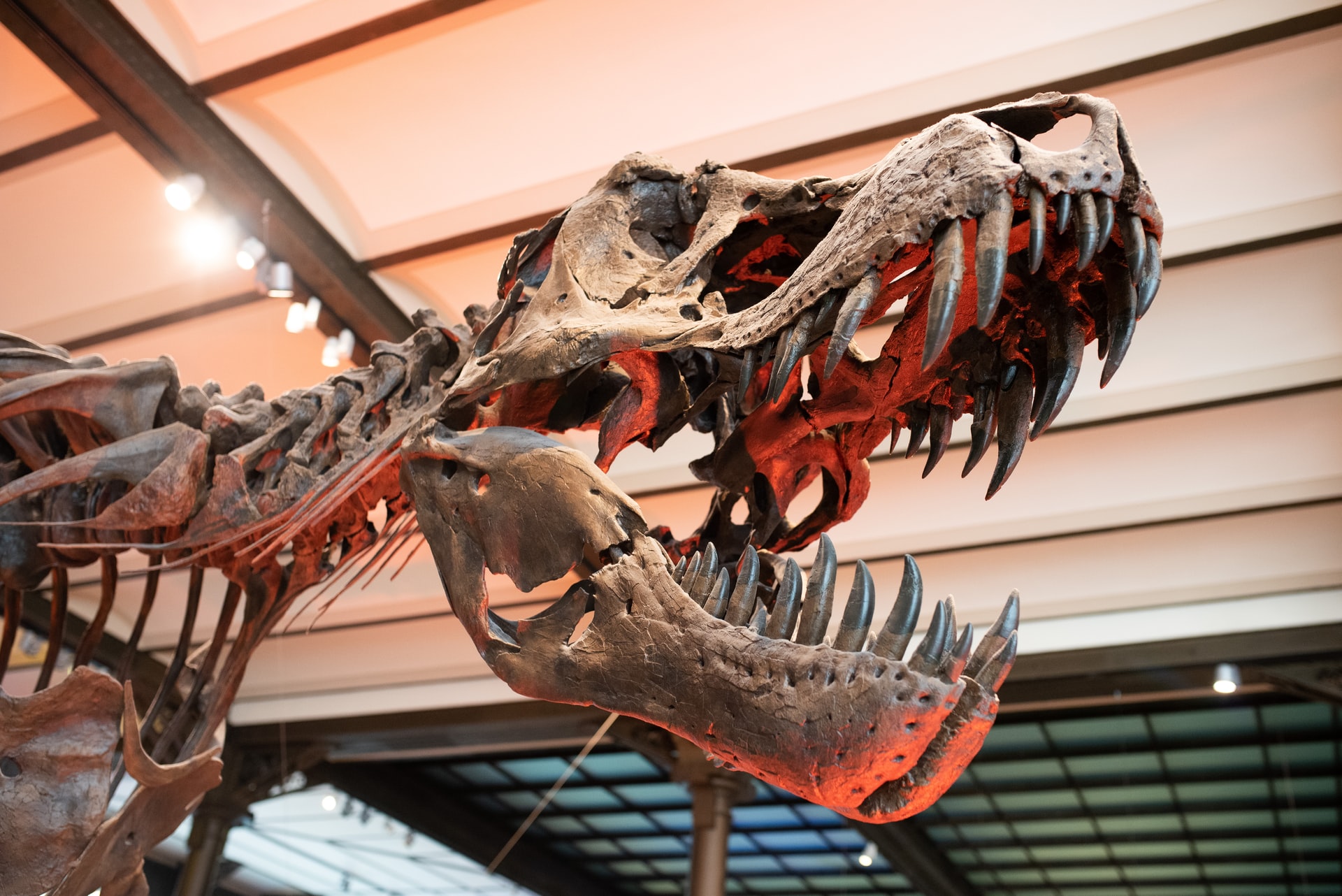Discovering dinosaurs in Brussels
The Museum of Natural Sciences in Brussels is an internationally renowned center for scientific research which houses the largest collection of dinosaurs in Europe! And, according to a study by the news channel CNN, the Museum is the third-best in the world.
Page Contents
Museum of Natural Sciences
The origin of the museum of natural sciences in Brussels dates back to 1751 when Karel van Lotharingen founded the natural history cabinet. Over the founding years, the cabinet has been the victim of several debts and looting, which led to the remaining pieces being sold to the Belgian state in 1846. This has ensured the museum to build up a collection for 250 years, which tells the story of the (Belgian) natural history.
This collection – which counts over 37 million objects (minerals, dinosaurs, insects, shells,..) – has mainly grown by digging up fossils, scientific expeditions, receiving royal gifts or treasures from congo. Because of this, the museum of natural sciences in Brussels is the third-largest in Europe, after those in Paris and London.
It goes without saying that this collection also contains some unique pieces, with the Belgian discoveries in Antarctica and the unique and complete iguanodon skeletons as showpieces.
Cran of the Iguanodons
When visiting the museum, you’ll immediately be confronted with the museum’s biggest showpiece: Thirty relatively complete iguanodon skeletons which were discovered in 1878 in a coal mine in Bernissart.
The find was a hugely important discovery for the world of pathology and its scientists: for the first time, there were complete skeletons that could show them what the dinosaurs looked like, allowing them to learn different things from their bones and teeth structure.
This made the news of the discovery go viral, which attracted visitors from all over the world. The fossils were referenced as the “Mona Lisa of the fossils” and the coal mine was referred to as the “Cran of the Iguanodons”.
The discovery of the Iguanodons
The Iguanodon fossils were found in a coal mine at a depth of more than 320 meters, which originally looked like a clay pit filled with golden trees … which turned out to be dinosaur bones filled with pyrite. Pyrite is a mineral which shines like gold, but is actually worthless, hence why it’s called ‘Fool’s Gold’.
Because the pyrite pulverized the bones when they were removed from the coal mine, it was decided to wrap them in plaster first, so they were safe for transport. In the years after the discovery, over 130 tons of fossils were transported from Bernissart to Brussels, where they were thoroughly cleaned in the museum’s laboratories.
In 1882 Louis De Pauw started assembling the dinosaurs, and in 1883 the first skeleton was put on a display in the inner courtyard of the former Nassau hotel, where it was kept inside a glass case to protect it from the bad weather. Because the Nassau hotel became too small for all the skeletons, the iguanodons moved to Park Leopold, to finally end up in its current location in 1902.
While the iguanodons have been in its current location since 1902, the skeletons were exposed to bad condition, which is why the scientists of the museum had to give the bones an extra layer of alcohol and shellac that now gives it its brown color.
Bernissart’s other treasures
Since the discovery of these legendary iguanodons skeletons, various other fossils have been found in the Bernissart coal mines: from ancient fish fossils, to plant remains and skulls of rare turtles.
During a recent (2002 – 2003) drilling and 3D scan, the results showed that there were still several fossils in the mine, but that they are (too) deep underground to recover.
Antarctica
Another showpiece of the museum is the Belgian finds, discoveries, and expeditions in Antarctica.
You would hardly realize it, but Belgium has a close relationship with Antarctica because of the number of expedition missions that have taken place: It started in 1897 when Adrien de Gerlache started his first South Pole expedition with the “Belgica”. Being the first scientist in this area, he discovered several new animal species, allowing him to publish more than 90 books on them over the years.
His discoveries have led to the creation of the “Belspo”-project (founded in 1983) and the creation of the Belgian “Princess Elisabeth”-research center.
This Antarctica exhibition in the Museum of Natural Sciences of Brussels does not only talk about the Belgian projects which have taken place, but also about the harsh conditions in Antarctica, how animals live in this continent and how their bodies are built for it.
A lot more to discover
The museum for example also tells the story of the construction and walling of the 12 fortresses of Antwerp – which only lasted a few days in WWI – where various whale fossils were found during the excavation work, which turned out to be quite rare in retrospect.
There is much more to tell you about the museum and its pieces, just because the museum has such a large collection! We won’t spill all the beans right now, but we’d advise you to look into the wing which contains all the minerals or the rooftop wing where you can discover more about the evolution of life.








